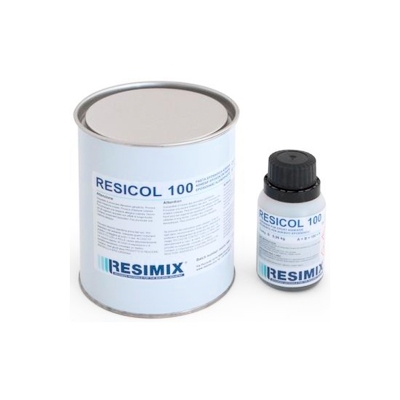RESICOL 100
THIXOTROPIC EPOXY ADHESIVES FOR STRUCTURAL BONDING AND CONCRETE SMOOTHING
Solvent-free, thixotropic epoxy adhesive for structural adhesion of concrete, iron, wood, brick, marble, carbon fibre etc.
- Thanks to its high thixotropy, RESICOL 100 adhesive can be vertically applied on thicknesses up to 3 mm and in the intrados with no risk of dripping; RESICOL 102 can be applied on vertical surfaces with thicknesses up to 6 – 7 mm;
- High mechanical compression strength and bending features;
- Excellent adhesion thanks to hardening with no shrinking and excellent compatibility with different building materials: concrete, bricks, stone, wood, steel;
- Good chemical resistance to diluted acid and basic solutions;
- Good resistance to pollution and saline fogs;
- Excellent dielectric properties (low electric conductivity);
- It achieves high mechanical properties only a few hours following application;
- Pre-weighed packages, ready for use.
| U.M. | ||||||||||||||
|---|---|---|---|---|---|---|---|---|---|---|---|---|---|---|
| Compression strength | > 97 | N/mm2 | ||||||||||||
| Bending strength | > 30 | N/mm2 | ||||||||||||
| Elastic modulus | 9290 | N/mm2 | ||||||||||||
| Adhesion to dry concrete | > 4 | N/mm2 | ||||||||||||
| Adhesion to damp concrete | > 2 | N/mm2 | ||||||||||||
| Adhesion to steel | > 3,5 | N/mm2 | ||||||||||||
| Glass transition point (calorimetric method) | ca. 53 | °C | ||||||||||||
| Density | 1,95 | kg/dm3 | ||||||||||||
| A + B mixture ratio | 100 + 6 |
Preparation of the support
Smoothing: the surfaces to be coated must be compact, clean (no oil or fat), dry (support damp <5%) and mortar grout and crumbly part-free. For better adhesion the surface must be slightly roughened with sandblasting or sanding; then remove any sign of dust or dirt using an exhauster.
Gluing and mending: in case of gluing or repair of a cracked element, we recommend opening up the crack as much as possible by possibly moving away the parts to be glued (in case of doorstones, steps or non-movable parts); remove the crumbling parts with abrasive disk, brush or scraper and thoroughly clean with vacuum cleaner or compressed air.
Metals must be sanded to SA 2,5 degree or alternatively grinded or vigorously cleaned with metal brush and then treated with RESICOLOR 425 specific primer.
The presence of water has a negative effect on adhesion. Wet foundations must be dried up as much as possible using air or, better, using gas flame.
Preparation of the product
Pour component B into component A and blend at slow speed for 3’ – 5’ using drill with helix/spiral to reduce air inlet as much as possible; during this operation, scrape also the bottom and the sides of the container.
Application
Smoothing: apply the material with a steel or nylon palette knife.
Gluing and mending: apply the material on the gluing surface using a knife or trowel in 2 to 4 mm thicknesses based on the surfaces to be glued/joined and moderately press the elements until some adhesive comes out from the sides, then make sure they remain pressed/places until hardening (6 hours at 20 °C).
Notes
Packages are weight pre-measured out: fully use all components A and B. If you wish to divide the package, products must be weighed by respecting the A+B ratio on the label and must not be weighed out based on the volume
By pouring B component into A component, the hardening reaction starts: following mixture the time available is limited and it depends on the temperature.
In case of both products the temperature of the support must be of at least 5 °C.
| Temperature | Use (pot-life) | hardening | ||||||||||||
|---|---|---|---|---|---|---|---|---|---|---|---|---|---|---|
| 10 °C | 80' | 10 hours | ||||||||||||
| 20 °C | 60' | 6 hours | ||||||||||||
| 30 °C | 45' | 4 hours |
Gluing and smoothing: approx. 1.9 – 2 kg/m² for a layer 1 mm thick.
Lamination of carbon materials: 2 – 3 kg/m2.
RESICOL 100 is available in 1kg and 5 kg packages (A + B component).
If stored in its original and sealed package, the products remains unaltered for a year if kept in environments with a temperature between 10 and 30 °C.
- Mending and structural gluing of building materials: concrete, fibre cement, iron, wood, stone, marble;
- Smoothing and stuccoing of surfaces subject to abrasion/erosion;
- Stuccoing the omegas of forming concrete;
- Stiff structural gluing of prefabs in concrete (slabs, pipes);
- Stuccoing the cracks and gluing of the injectors before the injection of RESISYSTEM 310/312 or with REPIKIT 310/312.
- Structural reinforcement of concrete beams by gluing a thin layer of steel (beton placquè) or plating with thin layers of carbon;
- Gluing and lamination of tapes in carbon fibre to reinforce wooden beams.

